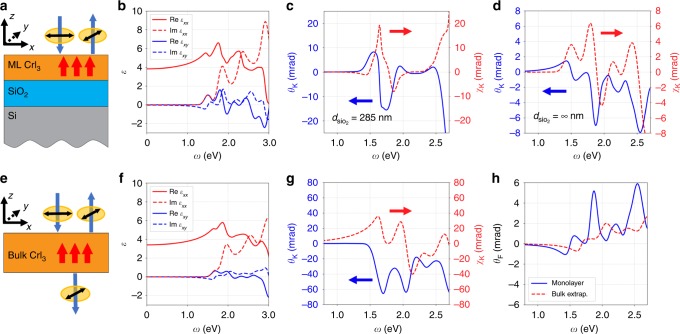Fig. 4.
MO signals calculated from first-principles dielectric functions. a P-MOKE setup consisting of layers of vacuum, ferromagnetic monolayer CrI3, SiO2 film, and semi-infinitely thick Si. Red arrows denote the out-of-plane magnetization, which is pointing along the +z direction. Blue arrows denote the propagation direction of light, and black double-headed arrows give the corresponding linear polarization direction. Each orange ellipse denotes a polarization plane of the electric field of light. b Calculated real part (solid lines) and imaginary part (dashed lines) of both the diagonal εxx (red) and off-diagonal εxy (blue) dielectric functions of ferromagnetic monolayer CrI3, using a monolayer thickness d = 6.6 Å. An 80 meV energy broadening is applied. c Kerr angle θK (left, blue solid) and Kerr ellipticity χK (right, red dashed) for the P-MOKE setup with a 285 nm SiO2 layer. d Kerr angle θK (left, blue solid) and Kerr ellipticity χK (right, red dashed) for the P-MOKE setup in (a) with semi-infinitely thick SiO2 layer. e P-MOKE and P-FE setup of a suspended ferromagnetic bulk CrI3 layer with the directions of light propagation and magnetization similar to (a). f Calculated real part (solid lines) and imaginary part (dashed lines) of both the diagonal εxx (red) and off-diagonal εxy (blue) dielectric functions of ferromagnetic bulk CrI3, with an 80 meV energy broadening. g Kerr angle θK (left, blue solid) and Kerr ellipticity χK (right, red dashed) for the setup in (e) with infinitely thick ferromagnetic bulk CrI3. h Comparison between Faraday angle θF of a suspended ferromagnetic monolayer CrI3 and extrapolated bulk value down to the monolayer thickness (6.6 Å)

